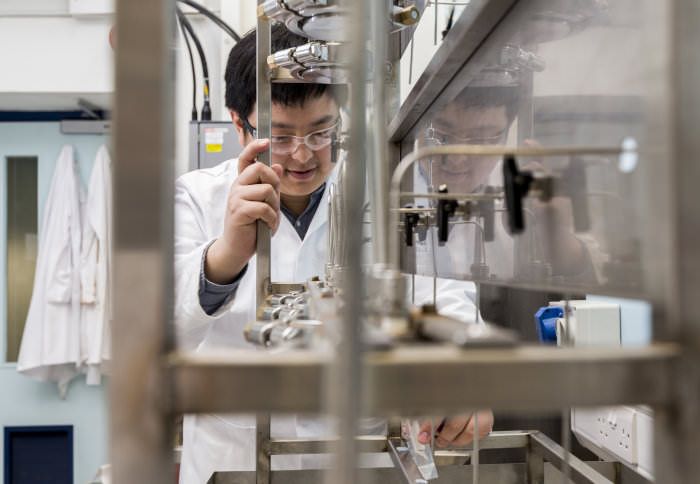Ground-breaking Insight into Ultrathin Membranes Improves Desalination Processes (+VIDEO)
Published on by Water Network Research, Official research team of The Water Network in Academic
Researchers from the Livingston Group have uncovered new insights into membrane technology, paving the way for future research opportunities and industrial applications.
by Sara West
An ultrathin polyamide nanofilter, also known as a membrane, is a very thin filter comprised of two parts – a thin polyamide film and a support layer on which the polyamide film sits.
Nanofilters are an important component in water purification processes such as desalination, filtering impurities and creating clean drinking water. They've been used by industry for decades, but little research has been conducted to understand their properties and how they function. Recent research from the Livingston Group at Imperial College London published in Advanced Materials addresses this need.

Source: Imperial College London
Improving industrial desalination processes
New research, funded by the $100m BP International Centre for Advanced Materials (BP-ICAM), is studying the fundamental science of membranes to improve the efficiency of off-shore water desalination processes, to reduce the amount of energy used in oil extraction and increase the efficiency of the process.
The oil and gas industry uses nanofilters in off-shore rigs to remove salt from sea water, so that low salinity water can be pumped into reservoirs to extract oil reserves. When studies showed that using low salinity water compared to salt water can lead to a significant increase in production, the oil and gas industry turned their attention to improving desalination processes.
Dale Williams, Senior Process Engineer at BP, explained: “In our Upstream operations we need to use large volumes of water to support oil and gas production. This water is typically sea water, so we have to treat it for it to be suitable for injection into our wells. If we also remove a large proportion of the salt that is in solution, this enables a greater proportion of oil be swept from the surface of rocks.”
Sheetal Handa, Associate Director of the BP-ICAM at BP, added: “Membranes give us the opportunity to take sea water and to generate the low salinity water that we need to recover more oil and maximise our operational efficiency. Crucially, this requires us to really understand the fundamental composition and workings of polyamide membranes, which the BP-ICAM research carried out in Professor Livingston’s Group is delivering to BP.”
Innovation in membrane research
The research team began by separating the layers of the nanofilter so they could study each one separately. Through experimentation they reduced the thickness of the polyamide film to just 6 nanometres, the thinnest usable nanofilter ever reported, and found this enhanced the speed with which water could pass through.
Next they began analysing the properties of the support layer, which provides the mechanical support function for the overall filter. It was previously thought that this layer had little overall impact on the efficiency of the nanofilter, but investigation by the researchers produced some surprising results.
The research team found that the support layer of the nanofilter had a noticeable impact on performance as it acted as another barrier through which water had to pass.
Dr Zhiwei Jiang, Research Associate at the Department of Chemical Engineering, explained: “The more porous the support layer, the better the performance of the film, because the water has to travel a finite distance to find pores through which to escape. The more porous a material, the more opportunities there are for the water to filter through. In the future we hope to optimise the filter performance by ensuring higher porosity support layers are routinely included in the production of filters.”
The work of the Livingston Group has opened up many possibilities for future research. As well as experimenting with creating even thinner filters, they are working on developing thin polyamide layers into carbon nanosheets, which might be conductive or transparent to light.
Professor Livingston added: “It’s fundamental research but with clear industrial applications in mind. This work is only possible because of the people on my team and BP’s vision to understand the properties of the materials they use. We’re lucky that Imperial attracts such talented and dedicated researchers as Dr Zhiwei Jiang. He possesses a wonderful combination of practical engineering and scientific skill coupled with creative thinking – this is what transforms good research into outstanding research.”
Water Transport through Ultrathin Polyamide Nanofilms Used for Reverse Osmosis by Zhiwei Jiang et. al. has been published in Advance Materials, Volume 30, Issue 15 (2018) and can be accessed at the following link: https://doi.org/10.1002/adma.201705973
Source: Imperial College London
Attached link
http://www.youtube.com/embed/vW2wgpk58C0Media
Taxonomy
- Treatment
- Ultrafiltration
- Filtration
- Membranes
- Filtration
- Desalination
- Membrane Technology
- Membrane Filtration
- Sustainable Desalination
- water treatment
- Desalination
- Membrane distillation